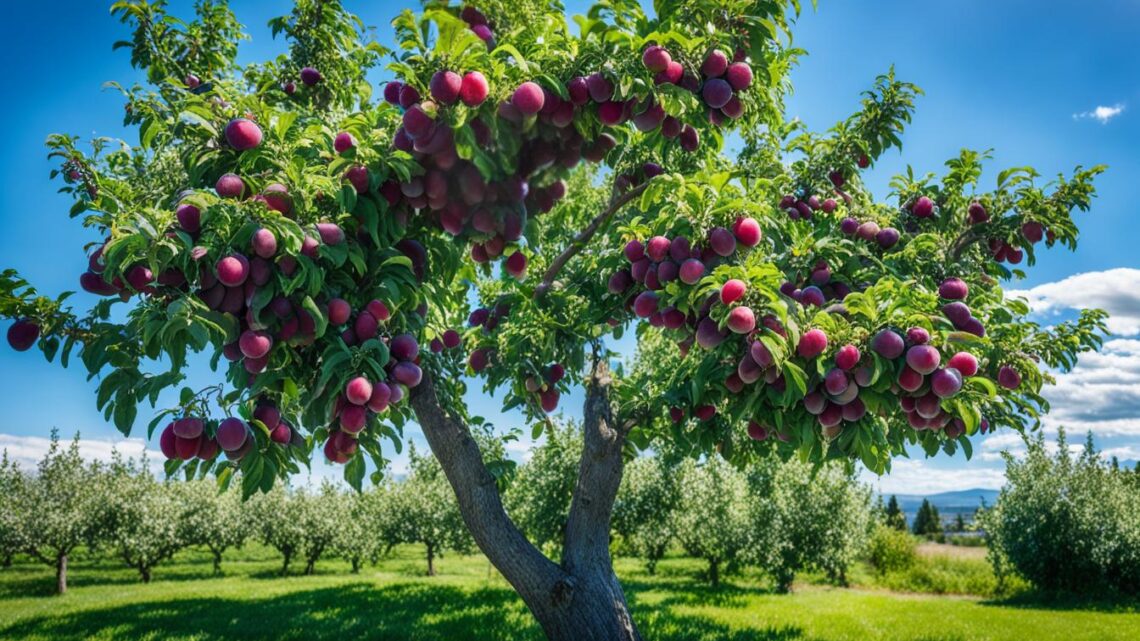
Ever wondered how to grow a plum tree and enjoy its sweet fruits? Plum trees are part of the rose family. They are both productive and varied, fitting many gardens and tastes. This guide is for anyone wanting to grow plum trees at home.
This article covers the different plum tree types and how to care for them. You’ll learn how to grow plums for eating, baking, or making jam. Get ready for a tasty adventure into the world of plum trees and their secrets.
Introduction to Plum Trees
Plum trees are part of the Prunus genus. They are loved for their tasty, juicy fruits. These fruits can be many colors, from deep purple to bright yellow. Plum trees can grow well in many places in the U.S. This lets people enjoy fresh, healthy plums.
Types of Plum Trees
There are three main types of plum trees: European plums, Japanese plums, and American hybrids. European plums do well in cooler places and can make fruit on their own. Japanese plums like warmer areas and need another tree to help them make fruit. American hybrids mix traits from European and Japanese plums, offering both hardiness and great taste.
Benefits of Growing Plum Trees
- Plum trees make your backyard look beautiful with their pretty spring flowers and green leaves.
- They produce a lot of fruit that you can eat fresh, bake, or save for later.
- Plums are full of vitamins, minerals, and antioxidants, making them a healthy snack.
- Having your own plum trees can cut down on grocery costs and give you fresh, tasty fruit.
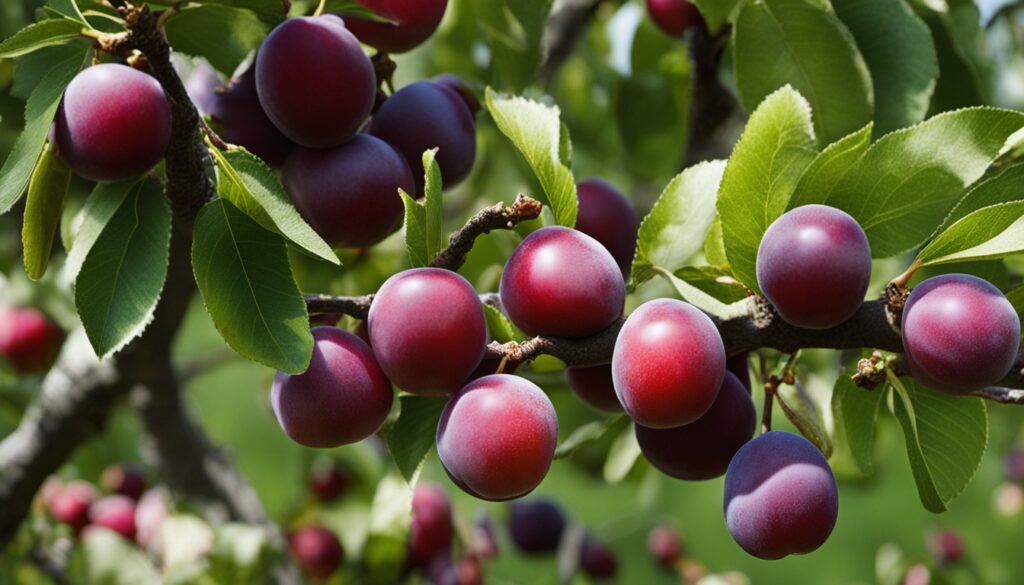
Choosing between European, Japanese, or American hybrid plum trees can bring many benefits to your garden. With the right care, you can have a plum tree that looks great and is good for you. It will make your senses happy and keep you healthy for a long time.
Selecting the Right Plum Tree Variety
Choosing the right plum tree means thinking about your area’s climate and growing conditions. Japanese plum varieties, like ‘Satsuma’, do well in warm places and give big, juicy fruits. European plums, such as ‘Stanley’, are better for cold areas and are often dried as prunes.
Japanese Plum Varieties
The Burbank Plum Tree is a favorite Japanese type that grows in USDA zones 5 through 9, getting 15-20 feet tall. The Laroda Plum Tree also does well in USDA zones 5 through 9, reaching 18-20 feet. The Santa Rosa Plum Tree is another Japanese type that grows best in USDA zones 5 through 9, reaching 15-25 feet.
European Plum Varieties
For colder areas, the Native American Plum Tree is a good choice that grows in USDA hardiness zones 3-8, getting 12-20 feet tall. The Damson plum is a favorite in Europe for cooking, making jams, and preserves.
| Plum Variety | USDA Hardiness Zones | Mature Height | Best Uses |
|---|---|---|---|
| Burbank Plum | 5-9 | 15-20 feet | Fresh eating |
| Laroda Plum | 5-9 | 18-20 feet | Fresh eating |
| Native American Plum | 3-8 | 12-20 feet | Fresh eating, cooking |
| Santa Rosa Plum | 5-9 | 15-25 feet | Fresh eating |
| Damson Plum | 5-9 | 12-15 feet | Cooking, jams, preserves |
When picking a plum tree, think about the climate, fruit size, taste, and how you plan to use it. Whether you want a Japanese or European plum tree, there are many options for growing tasty plums at home.
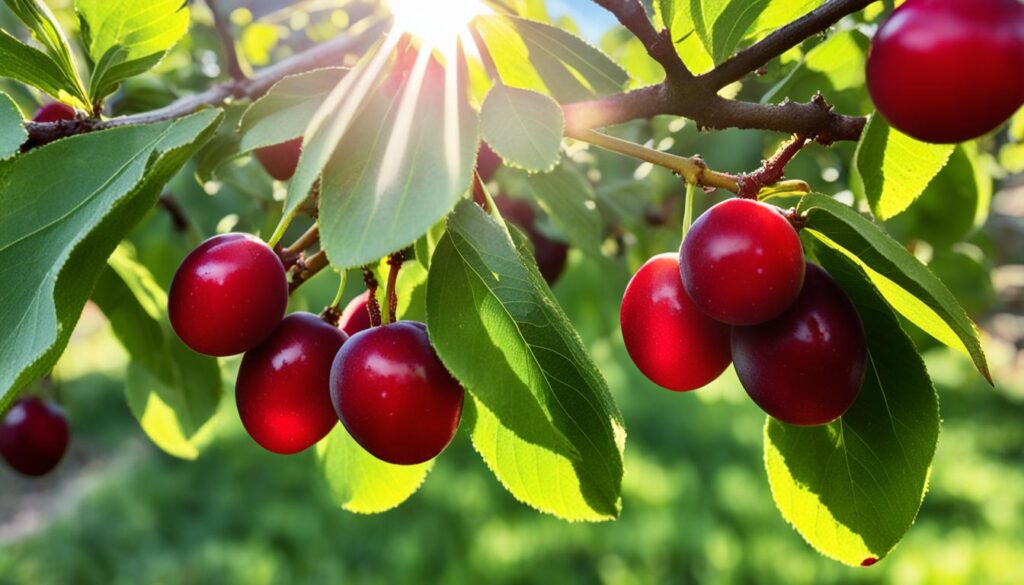
Plum Tree Site Selection and Planting
Choosing the right spot for a plum tree is key to its success. These trees need full sun, so they should get 6-8 hours of sunlight daily. The soil should drain well and be loamy, with a pH of 6.0 to 6.8. Don’t plant them in low spots that freeze easily, as spring frosts can harm their flowers.
For the best chance of fruiting, place your plum tree in a spot that gets some shelter. This could be a south- or west-facing area. When you plant, dig a hole a bit deeper and wider than the roots. Make sure the graft union is 1-2 inches above the soil. Water the tree well when you plant it and keep watering it regularly the first year.
How far apart you plant plum trees depends on their size. For regular trees, keep them 20-25 feet apart. For dwarf trees, it’s best to plant them 10-15 feet apart. This lets them grow without being too close. Remember, picking the right plum tree site and planting them correctly is key for their health and fruiting.

| Plum Tree Characteristic | Requirement |
|---|---|
| Sunlight | 6-8 hours of direct sunlight per day |
| Soil | Well-drained, loamy soil with a pH of 6.0-6.8 |
| Planting Distance |
|
| Graft Union | 1-2 inches above the soil line |
| Frost Protection | Avoid low-lying areas prone to spring frosts |
Plum Tree Care and Maintenance
Proper care and maintenance are key for healthy, productive plum trees. Let’s look at how to water and fertilize them for the best results.
Watering Requirements
Plum trees need regular watering, especially in their first year. Water them a lot every week to help them grow. Keep watering them often, giving them deep soaks at the soil line.
Let the soil dry out a bit before you water again. Watch your plum trees during dry times. Give them more water if they need it to prevent fruit drop.
Fertilizing Plum Trees
Give your plum trees fertilizer in the spring and early summer. Use a balanced fertilizer with lots of phosphorus. This helps them bloom well and produce fruit. Don’t fertilize in late summer or fall to avoid damage from frost.
- Apply 1 pound (0.5 kg.) of organic fertilizer or well-aged manure in March of the first and second year.
- Provide one cup (240 ml.) of calcium nitrate in May of the first and second year to support plum tree health.
By following these plum tree watering and plum tree fertilizing tips, your trees will do great. You’ll get lots of tasty plums.
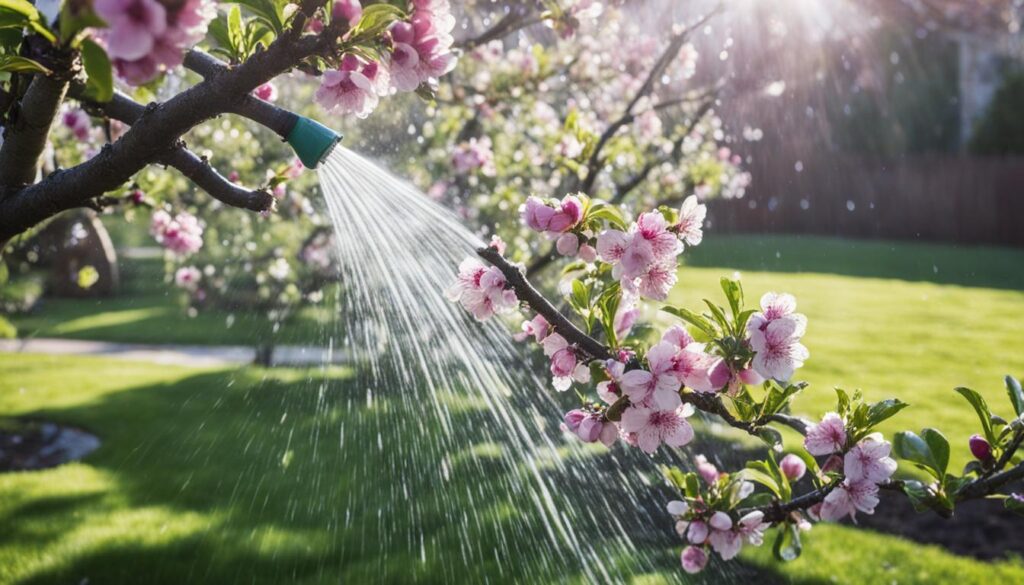
Pruning Plum Trees
Proper pruning is key for your plum trees’ health and yield. Whether you have Japanese plum trees or European plum trees, knowing how to prune makes a big difference. It affects the quality and amount of plums you get.
Pruning Japanese Plum Trees
For Japanese plum trees, aim for an «open center» shape. Cut the central trunk to let several wide-angled branches spread out. Thin the inside to keep air moving well. This shape helps plums grow better and keeps diseases away.
Pruning European Plum Trees
European plum trees should be pruned to a central leader shape. Keep one main trunk with branches going up the trunk. Prune to keep the tree’s shape and help it produce fruit. But don’t prune too much in the fall, as it can hurt the tree in winter. Taking some fruit off can also stop branches from breaking under heavy fruit.
It’s important to prune your plum trees in early spring or mid-summer. This avoids infections. Plums can get a fungal disease called silver leaf from bad pruning. Use sharp, clean tools and make cuts that help the tree grow strong and stay healthy.
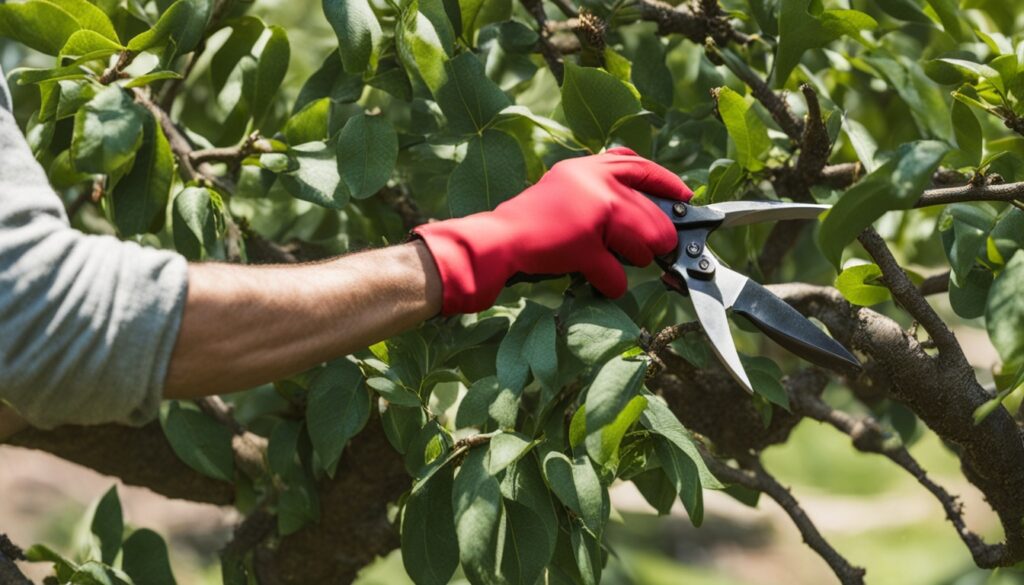
Pruning is vital for keeping your plum trees healthy and productive. By pruning the right way for your tree type, you’ll get lots of plums and a strong tree for many years.
Pollination Requirements for Plum Trees
Plum trees need the right pollination to grow lots of fruit. Most plums can’t pollinate themselves and need help from another tree. This means you need to plant different plum types together for best results.
But, the good news is that plums within the same type can pollinate each other. They just need to bloom at the same time and have bees and butterflies around. To get lots of plums, plant two or more kinds of plum trees in your garden.
| Plum Variety | Pollination Requirements |
|---|---|
| European Plums | Cross-pollinate between varieties like Coe’s Golden Drop, Stanley, Italian, and Seneca. |
| Japanese/Asian Plums | Varieties such as Blue Damson, Red Beauty, Sprite Cherry, and Santa Rosa can cross-pollinate. |
| American Plums | Chickasaw and American plums can be pollinated by each other. |
By picking the right plum trees and knowing how they pollinate, you can have lots of plums. Make sure to plant them close together. Also, have bees, butterflies, and hummingbirds around to help pollinate them.
Plum Tree Pests and Diseases
Plum trees face many pests and diseases. But, with care and watchfulness, you can beat these issues. Let’s look at common plum tree pests and plum tree diseases. We’ll also talk about how to fight them.
The plum curculio beetle is a big problem. It’s about ½-inch long and tunnels into the fruit. Japanese beetles, here since 1916, eat the leaves and fruit from July to September.
Plum aphids are tiny but harmful. They eat the leaves and hurt the tree’s health and fruit. Rust mites make leaves turn silver and curl, hurting the tree too.
| Pest | Description | Control Methods |
|---|---|---|
| Plum Curculio | A ½-inch long beetle that tunnels into the fruit | Pesticide applications |
| Japanese Beetle | Small beetles that infest plum trees from July to September | Shaking and disposing of the beetles |
| Plum Aphids | Under ½-inch in length, feed on leaves and affect tree health | Neem oil application |
| Rust Mites | Less than ¼-inch in length, cause leaves to turn silver and curl | Sulfur spray |
Plum trees can also get diseases. Brown rot shows as grey bumps on plums that turn to mush. Taking out bad fruit and harvesting right can fight this disease.
Winter moth caterpillars and lecanium scale insects harm plum trees. They eat leaves, buds, and hurt the tree’s health. By watching closely and using pest management, you can keep these plum tree pests and plum tree diseases away. This keeps your plum trees healthy and productive.
Harvesting and Enjoying Plum Fruits
Plum harvesting is a fun time. These juicy fruits are at their best. They start to ripen from late spring to mid-summer, depending on the type.
Japanese plums have a deep red to black skin and are firm. European plums are lighter in color and sweeter. They are perfect for baking and drying.
Plum Harvesting Tips
To pick plums, twist and pull them from the tree when they are fully colored and a bit soft. Plums don’t last long, so eat them fresh or preserve them quickly. It’s important to sort them to get rid of any bad ones.
Ways to Use Plum Fruits
- Enjoy plums fresh, as a healthy snack or addition to salads
- Preserve plums through canning, making jams, chutneys, or sauces
- Bake plums into pies, tarts, or cobblers
- Dry plums to create prunes for a convenient, shelf-stable snack
- Juice plums for a refreshing, nutritious beverage
Plums are a great fruit for cooking and eating. They come in many colors and flavors. Enjoy them fresh or turn them into delicious treats during the harvest season.
plum trees Chill Hour Requirements
Growing plum trees needs knowing about chill hours for fruit to grow. Chill hours are hours when the temperature is between 32°F and 45°F in winter. Each plum type needs different chill hours. Picking the right type for your area is key.
Japanese plums need fewer chill hours, from 150 to 450 hours. European and American hybrid plums need more, 400 to 700 hours.
| Plum Variety | Chill Hour Requirement |
|---|---|
| Japanese Plums | 150-450 hours |
| European and American Hybrid Plums | 400-700 hours |
It’s important to pick a plum type that fits your area’s chill hours. The right plum tree will wake up from dormancy and give you lots of tasty fruits. Knowing about plum tree chill hour requirements helps your tree do well and gives you sweet rewards.
Planting and Growing Timeline for Plum Trees
Starting with the right steps is key to growing plum trees. Plant them in early spring when the ground is thawed. Make sure the hole is a bit deeper and wider than the roots. Keep the graft union 1-2 inches above the soil.
Water the tree well when you plant it and keep watering it often in the first year. Don’t give it any fertilizer in the first year. Instead, focus on keeping the soil moist.
In the second year, start fertilizing in spring and summer with a balanced formula. This helps with growth and fruiting. Prune the tree in early spring or mid-summer to keep its shape and increase fruit.
By following this timeline, your plum trees will grow well and give you lots of fruit. Whether you choose Methley, Santa Rosa, Golden, or Scarlet Beauty, remember to plant at the best time, water often, fertilize wisely, and prune carefully. These steps will help you enjoy fresh plums from your own tree.



